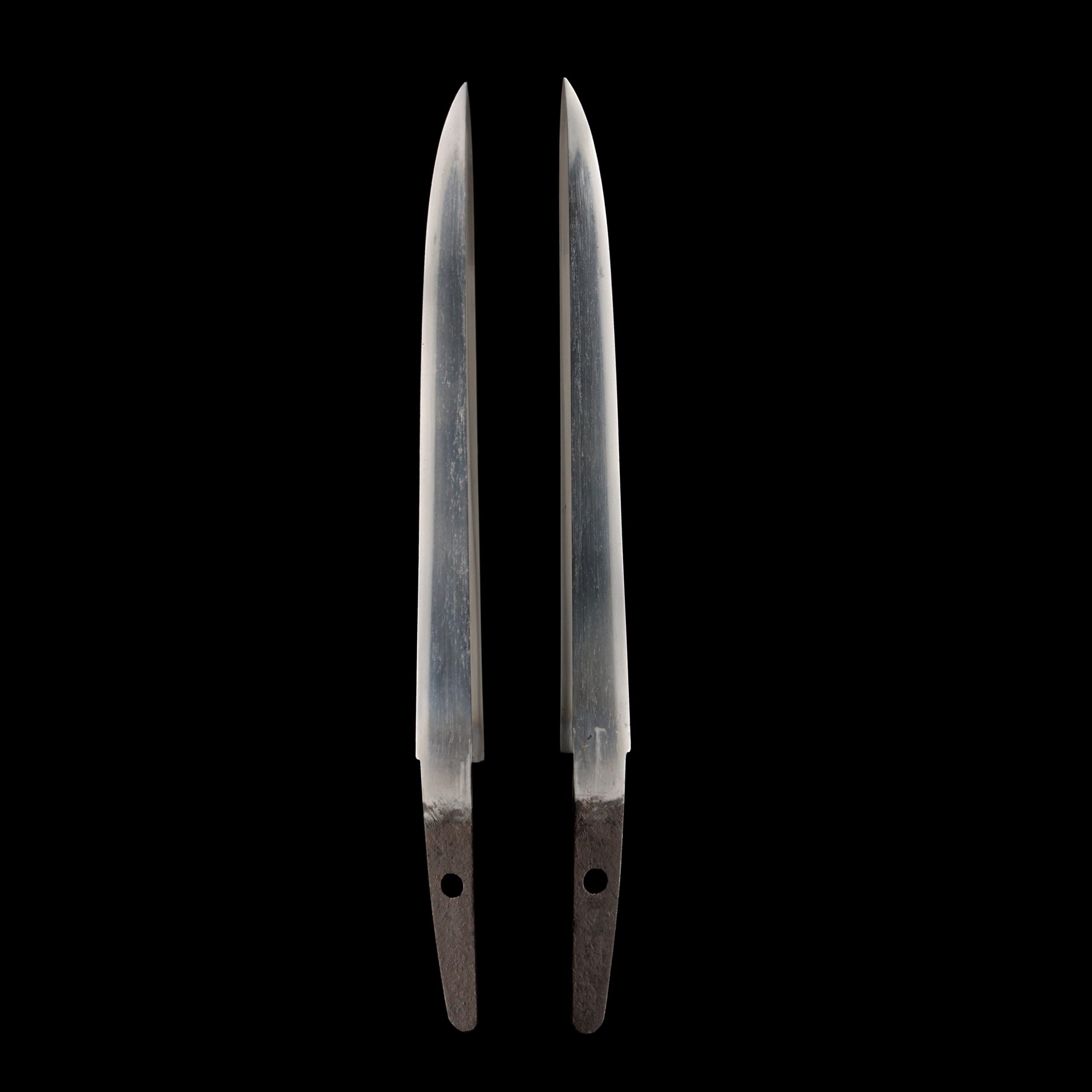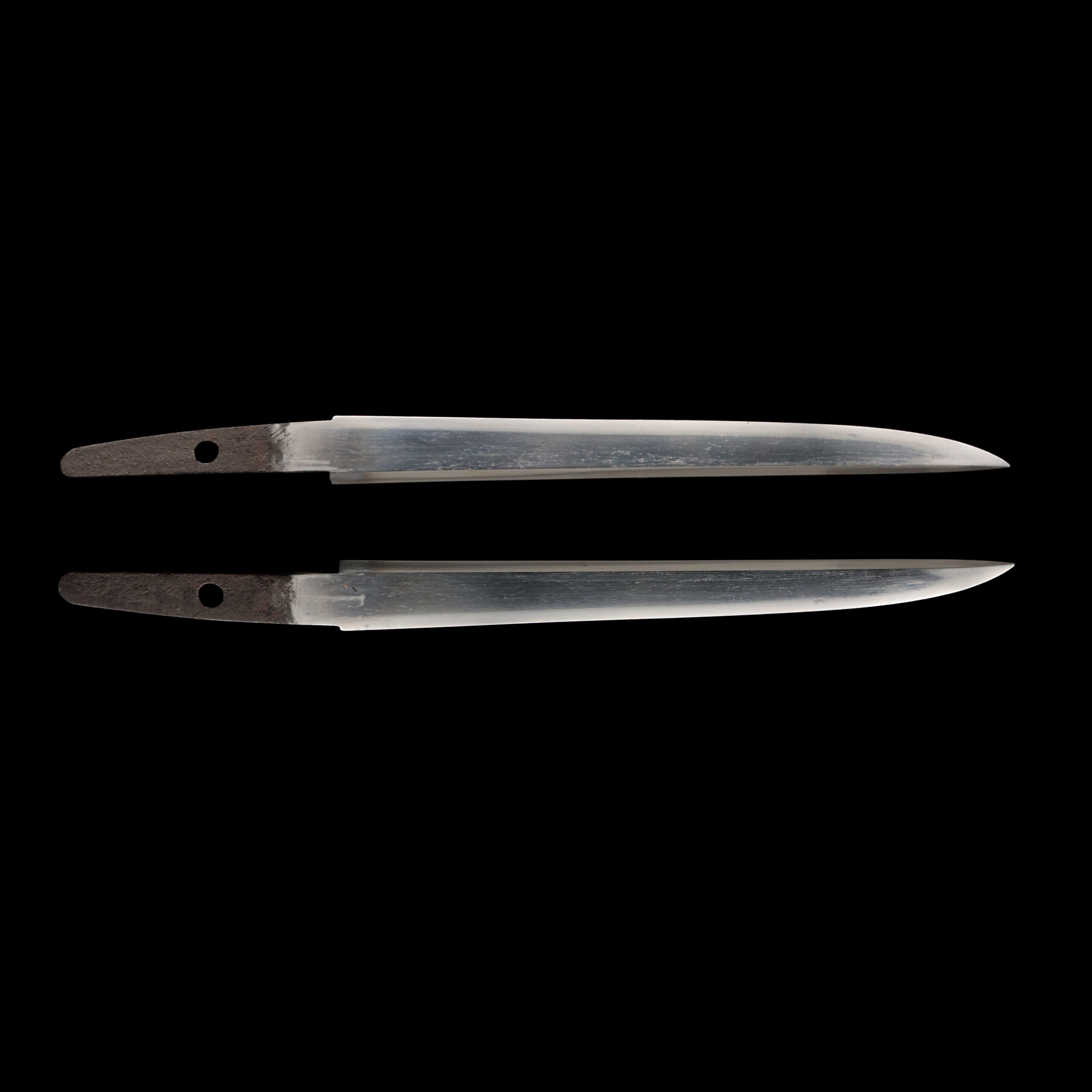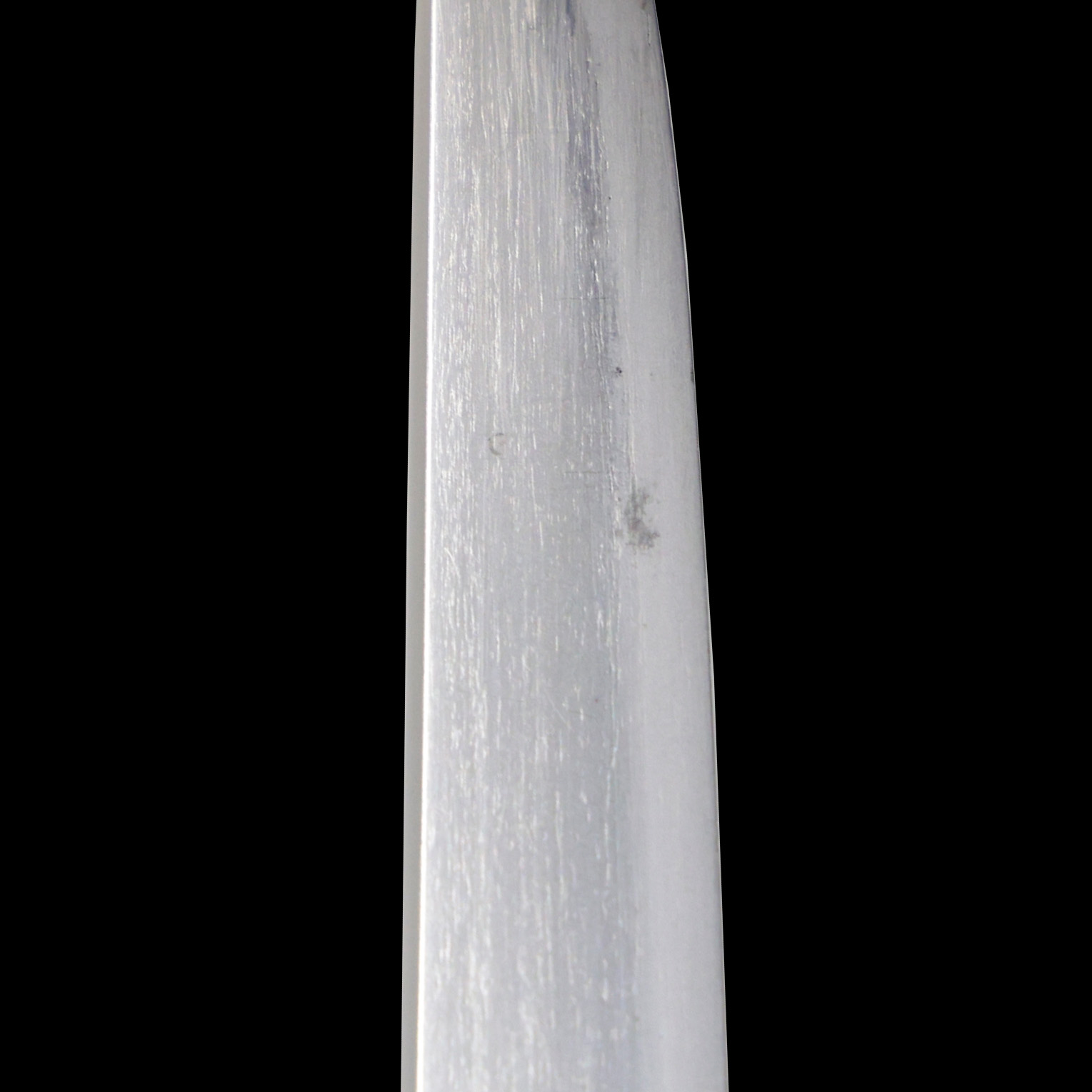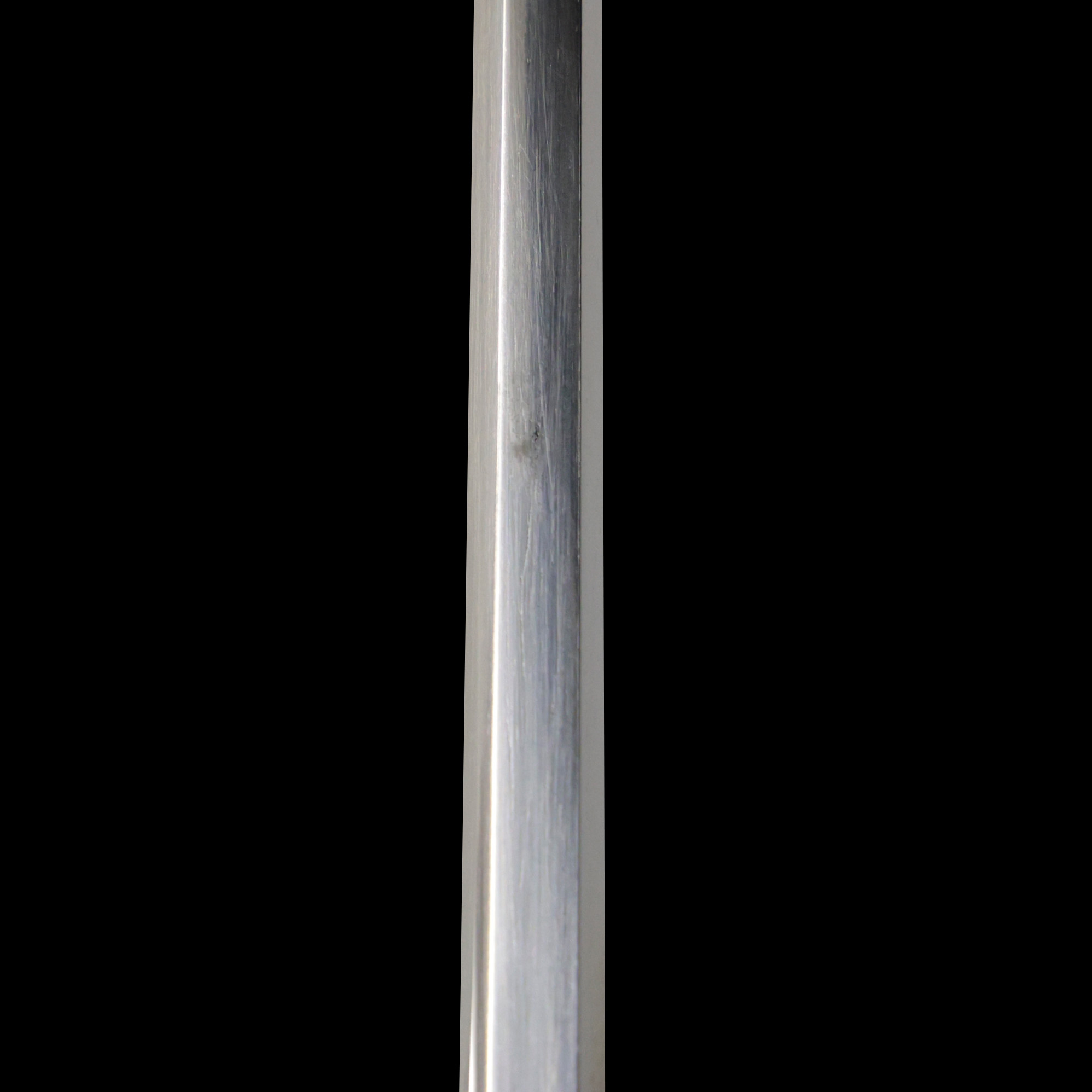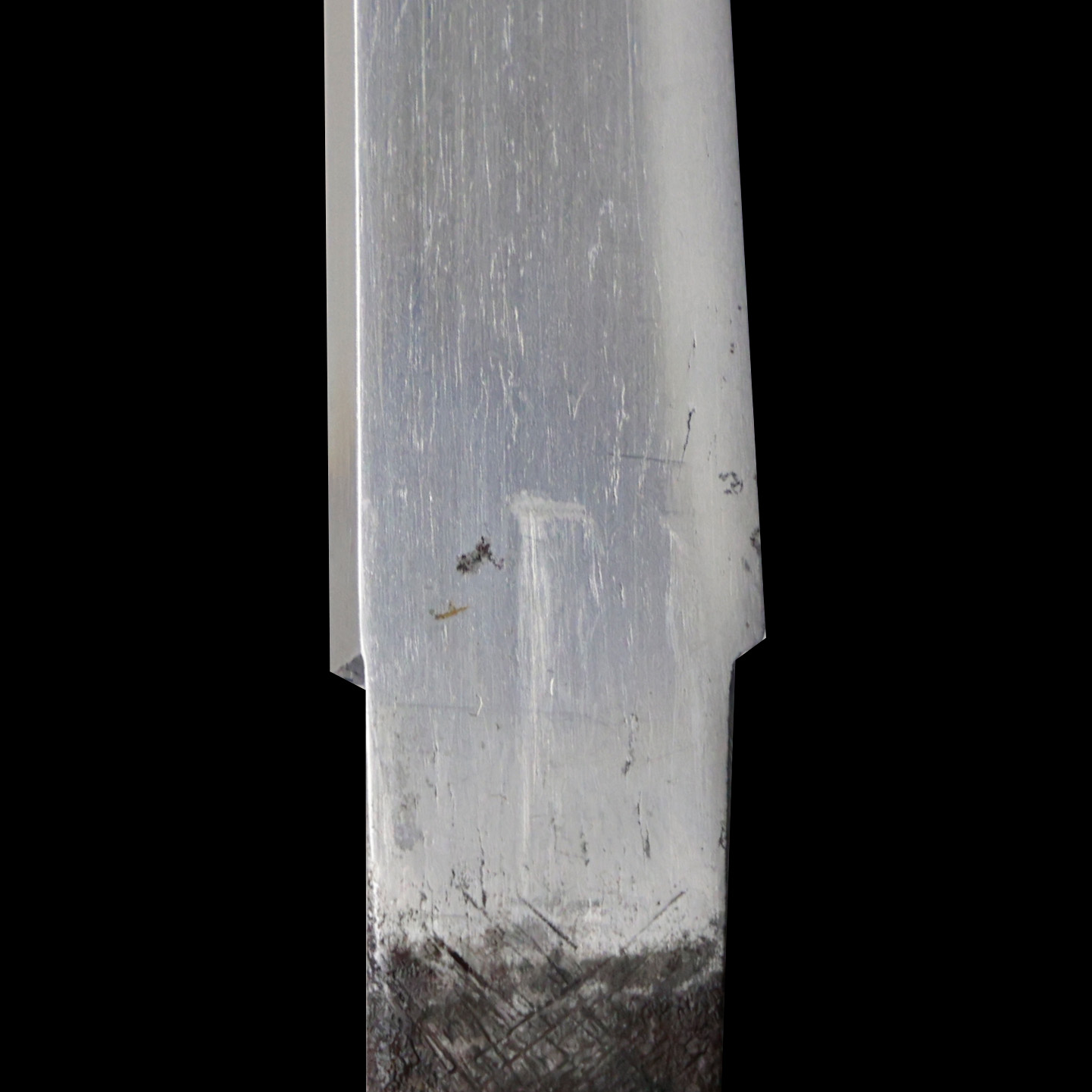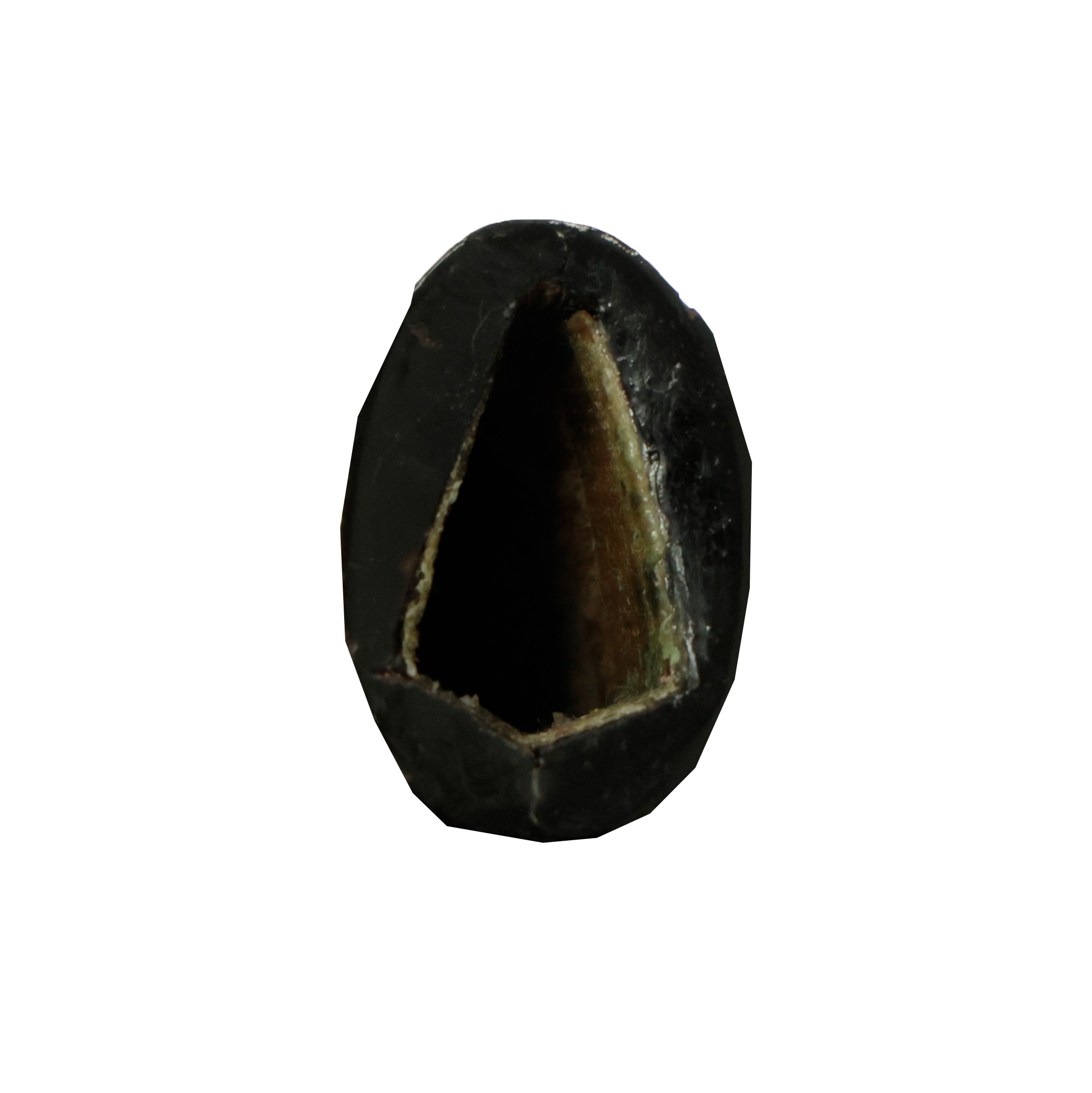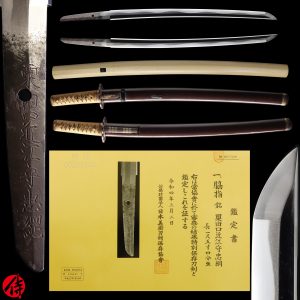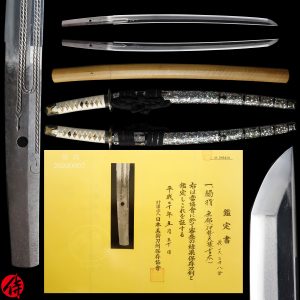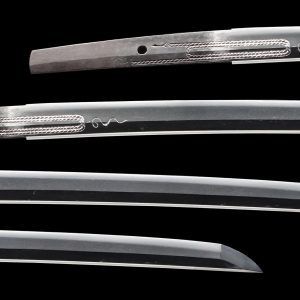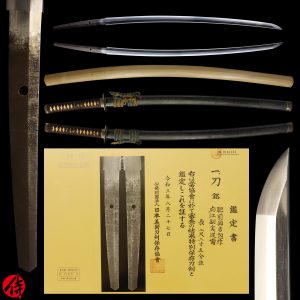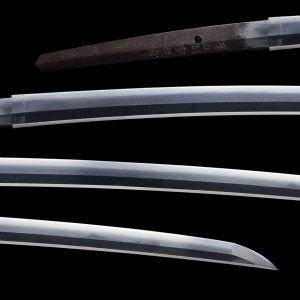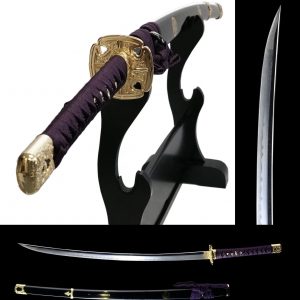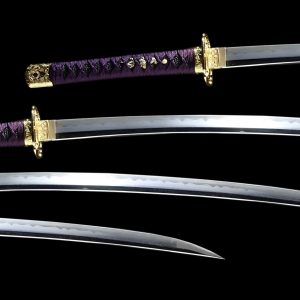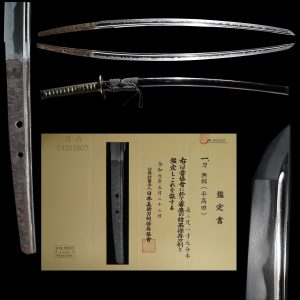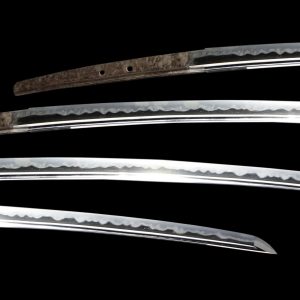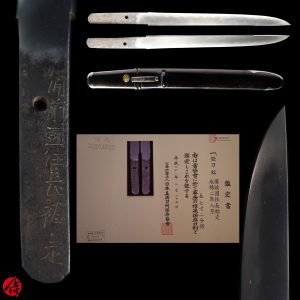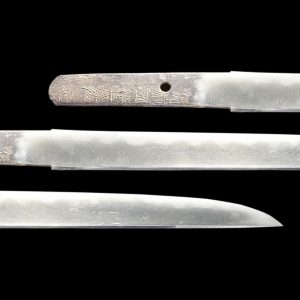Antique Japanese Sword Tanto Attributed to Kaneyoshi with NTHK Kanteisho Certificate
【Description】
Summary
This blade is attributed to Tegai Kaneyoshi (手掻包吉) during Eisho era (1504-1521: Late Muromachi period), according to NTHK’s appraisal. Kaneyoshi belonged to a prestigious school called Tegai school, which was founded by the first-gen Kanenaga. The maker’s name Kaneyoshi lasted a few generations. Considering the age mentioned in the authentication paper, we believe NTHK attributed it to a work of the late-gen Kaneyoshi based on its characteristics. The Tegai school was prosperous during the late Kamakura-mid Muromachi period (1288-1460). It is said that this school belonged to Todaiji temple, and it was located in front of the gate called Tengai Gate (輾磑門). The school name Tegai originally came from the sound of Tengai Gate.
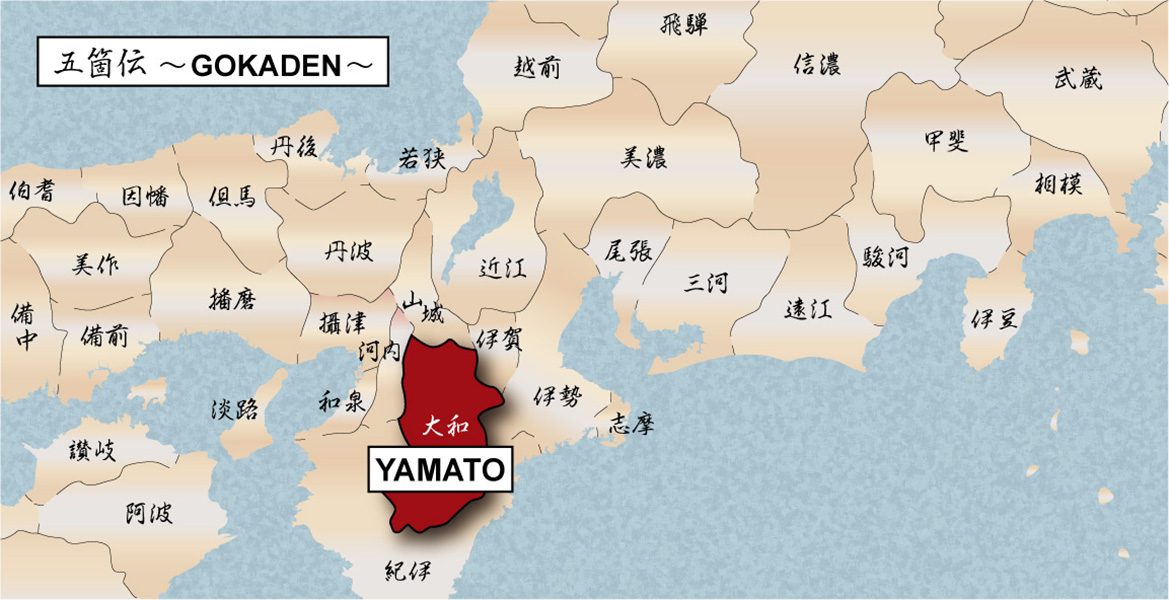
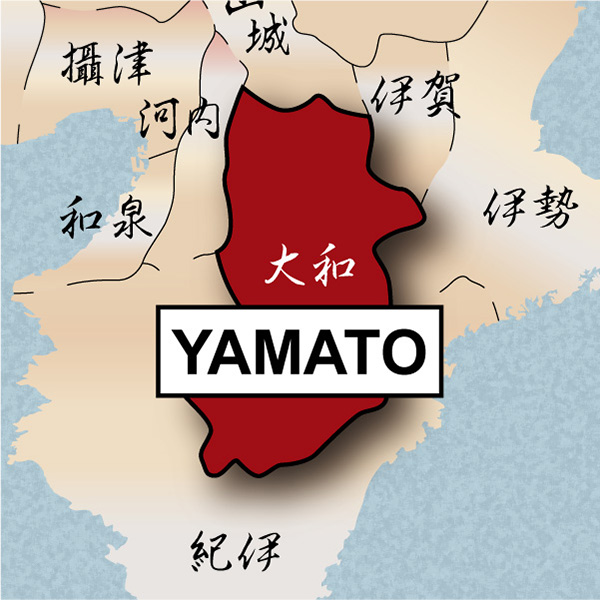
There were five prestigious schools, including Tegai school, during the Kamakura-Nanbokucho period in Yamato province. They are called Yamato Goha (大和五派); Senjyuin (千手院), Shikkake (尻懸), Taima (当麻), Hosho (保昌) and Tegai (手掻) school. They served politically powerful monks and temples in Nara, such as Todaiji temples. They were initially forging swords for military monks who became powerful due to the government’s policy back then.
Monks needed many weapons as there were many political rivalries between influential temples. They required strong weapons like swords to protect themselves. During this time, Tegai school or other Yamato sword schools met the requests from monks. They also forged blades for Samurai during their heyday. It is often the case that those who belonged to Yamato Goha didn’t inscribe their signatures.
Tegai school belonged to YAMATO DEN, which has the longest history among GOKADEN, five traditions of Japanese sword forging techniques. The blades forged by swordsmiths residing in the Yamato region are generally called Yamato Mono. The swords forged in the Yamato regions are famous for their beautiful Jigane, steel surface, and straight tempering line (Suguha). This blade has a beautiful Jigane with a Suguha tempering line, which shows an outstanding characteristic of the Yamato sword.
Yoroi Doshi (鎧通し)
This type of Tanto is called Yoroi Doshi (Armor piercing). The most notable characteristic of this blade is its Kasane (The thickness of the blade), which is suitable for aiming at armpits or neck area that is vulnerable even if Samurai armor is worn.
*Please keep in mind that there are a few Kitae Kizu on this blade. If you like to know the detailed condition, please feel free to contact us.
Cutting Edge Length(Nagasa):17.1 cm (6.73 inches)
Curvature(Sori):0 cm (0 inches)

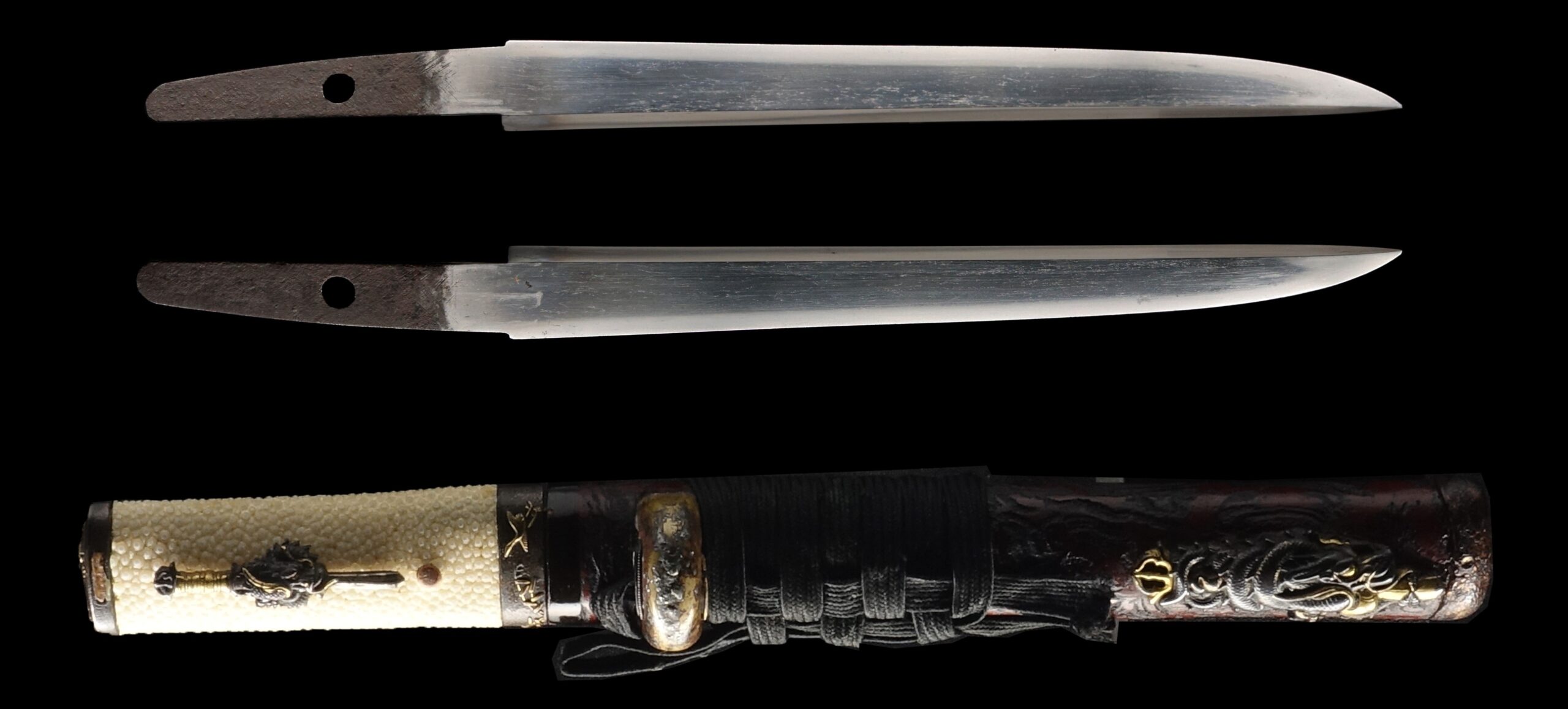
Hamon:
The crystalline structure which forms along the cutting edge of a blade as a result of the hardening process
Jimon(Jihada):
visible steel surface pattern created by folding and hammering during forging process
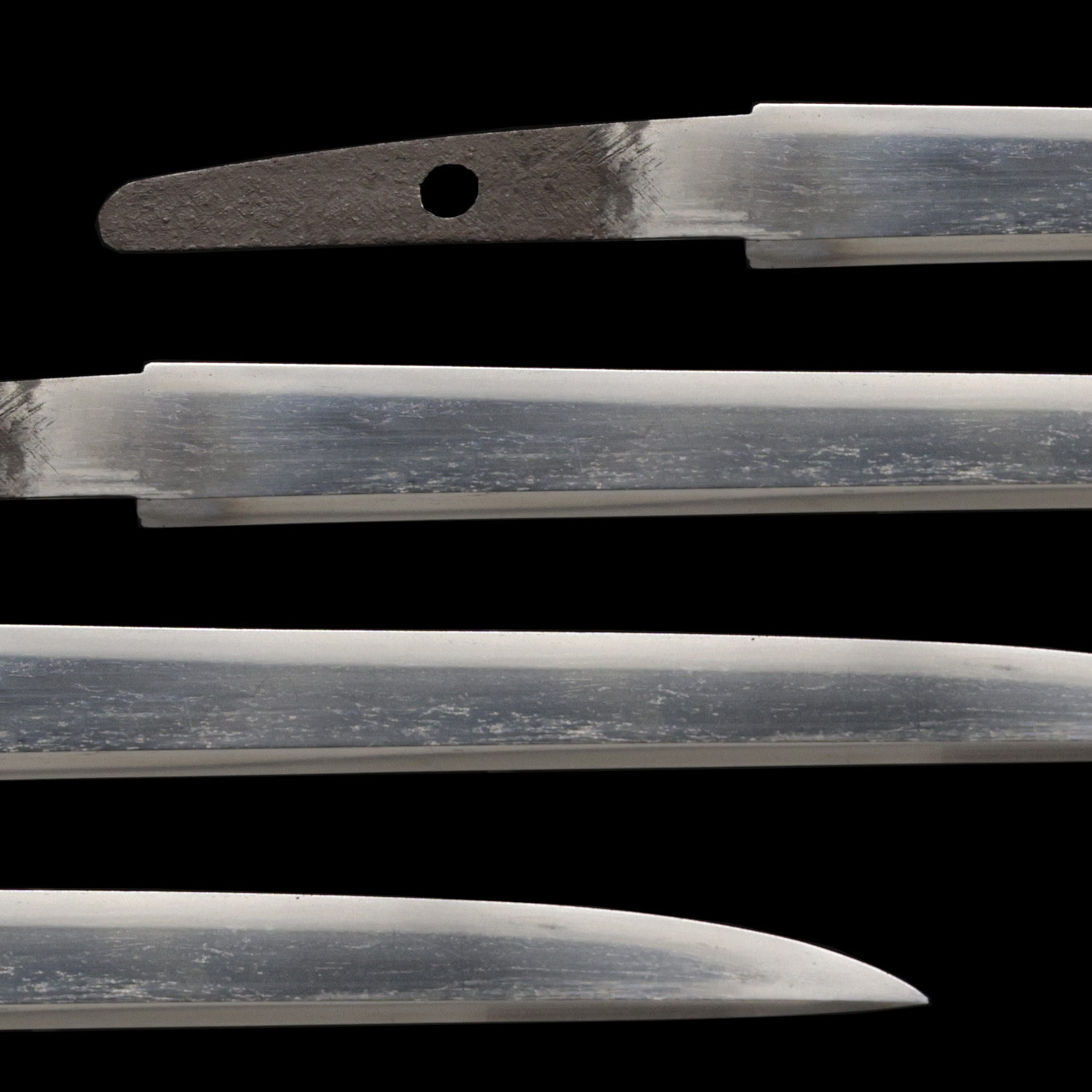
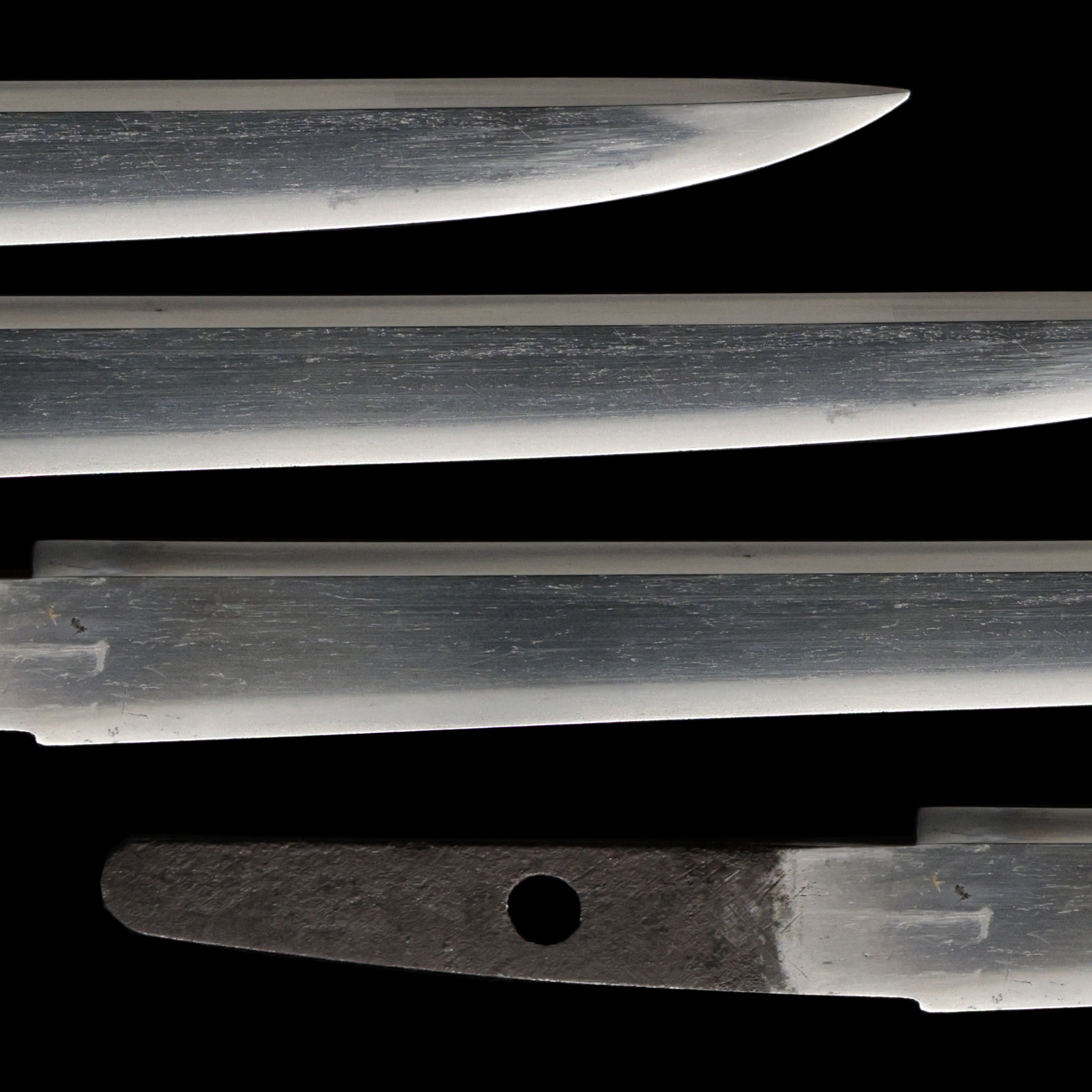

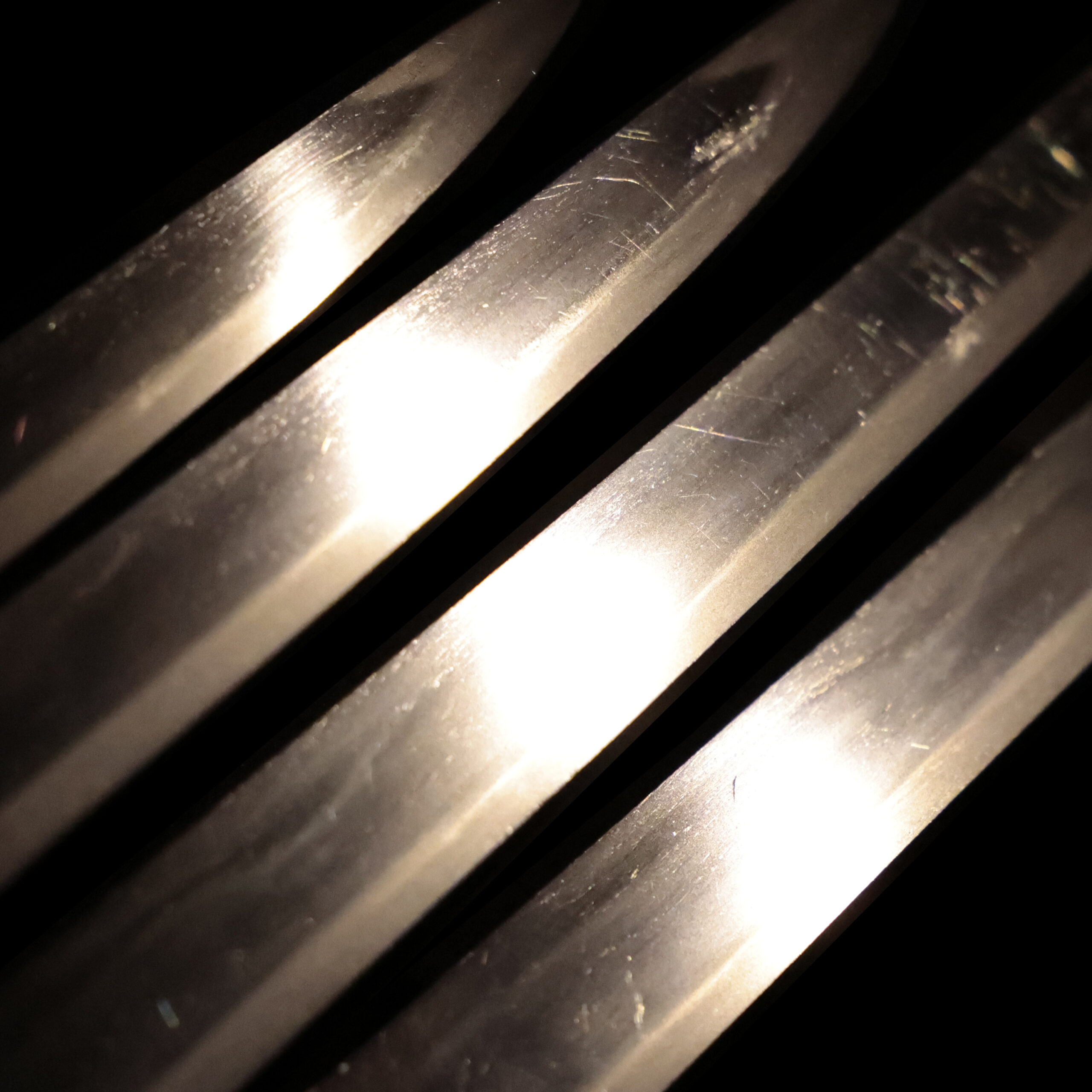
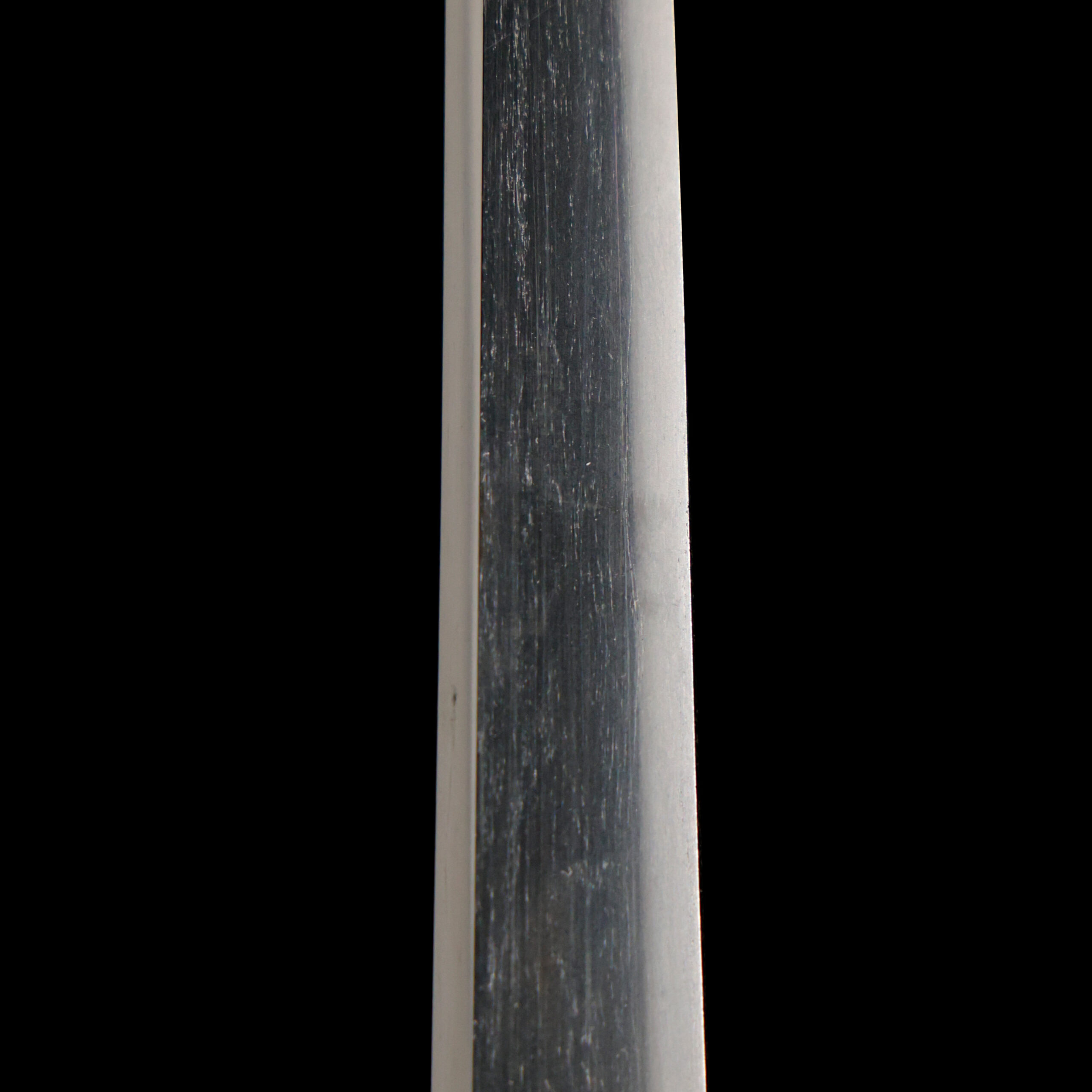

Kissaki:Kissaki is the tip of the Japanese sword.

Nakago:Nakago is the tang of the Japanese sword.
Japanese swordsmiths left the black rust on the tang because it prevents red rust while the tang is in its handle. And the discoloration of the tang was created over time, and it is a great indicator for a Japanese sword specialist to estimate when the sword was forged.

Koshirae: Koshirae is the mounting of the Japanese sword. There are several parts that consist of Koshirae such as Saya (Scabbard), Tsuka (Handle), Tsuba (Handguard).
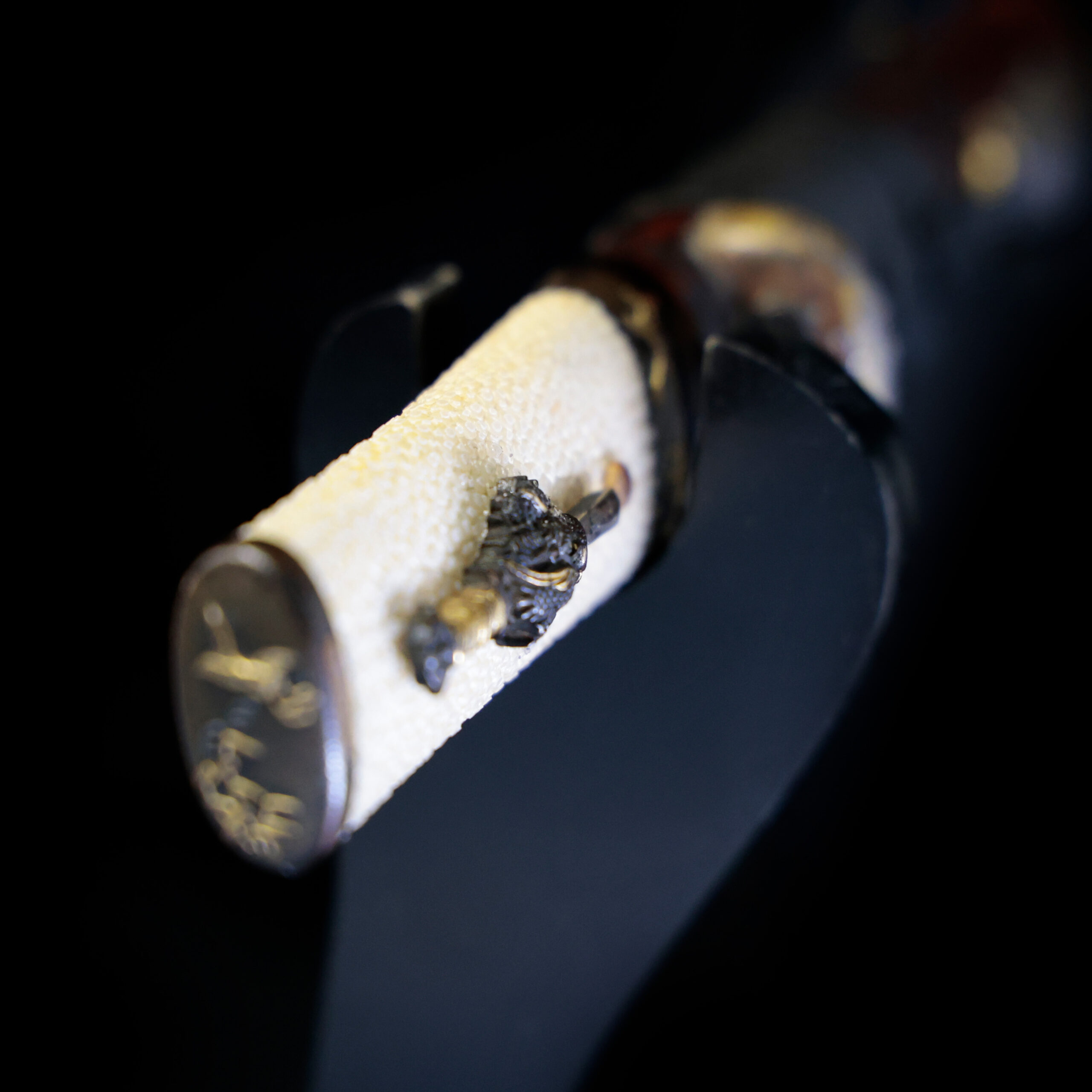
Fuchi-Kashira:A pair of matching sword fittings that cover the upper and bottom parts of its sword hilt.
The motif of this Fuchi Kashira is the combination of Kari (雁,wild goose) and Susuki (薄/芒, Japanese pampas grass), both of which are autumn symbols. Also, this combination called Susuki ni Kari (芒に雁) is used in Hanafuda (花札, a type of card game unique to Japan), which has been enjoyed since ancient times.
The wild goose is a migratory bird, arriving in Japan in autumn to overwinter and returning to the north in the spring. Therefore, it represents autumn. Also, because of its unique call, it is known as “a bird that carries good luck and good news,” meaning that it carries a message with its ancestors and brings good news. This bird was incorporated into designs for sword mountings and family crests. We would say this bird motif has been familiar to Japanese people since ancient times.
As for Susuki, this plant has been used as an offering to Gods. And some people have used it as an amulet to protect people from evil spirits. Also, in Japan, there is a group of plants that represent the autumn season that is called the Aki-no Nanakusa (秋の七草, the seven flowers of autumn). The Susuki is included in this group, and it shows how long this plant has been familiar to Japanese people.

Tsuka and Menuki:Tsuka is the handle of the Japanese sword and Menuki is its decoration.
This Menuki’s motif is Kurikara-Ken (倶利伽羅剣). Kurikara is the sword that Fudo Myo-O (不動明王, acalanātha) holds with his right hand. Fudo Myo-O is one of the objects of worship in Buddhism. According to a theory, it is the incarnation of Dainichi Nyorai (大日如来, Mahāvairocana, the principal image of esoteric Buddhism). Kurikara-ken was named after its appearance that Kurikara Ryu-O (倶利伽羅龍王, dragon) is winding around the sword. It is believed Kurikara-Ken could cut off worldly desires: Sandoku (三毒). Sandoku is the three fundamental human desires; Ton (貪, greed), Jin (瞋, anger, grudge), Chi (癡, delusion, complaint).
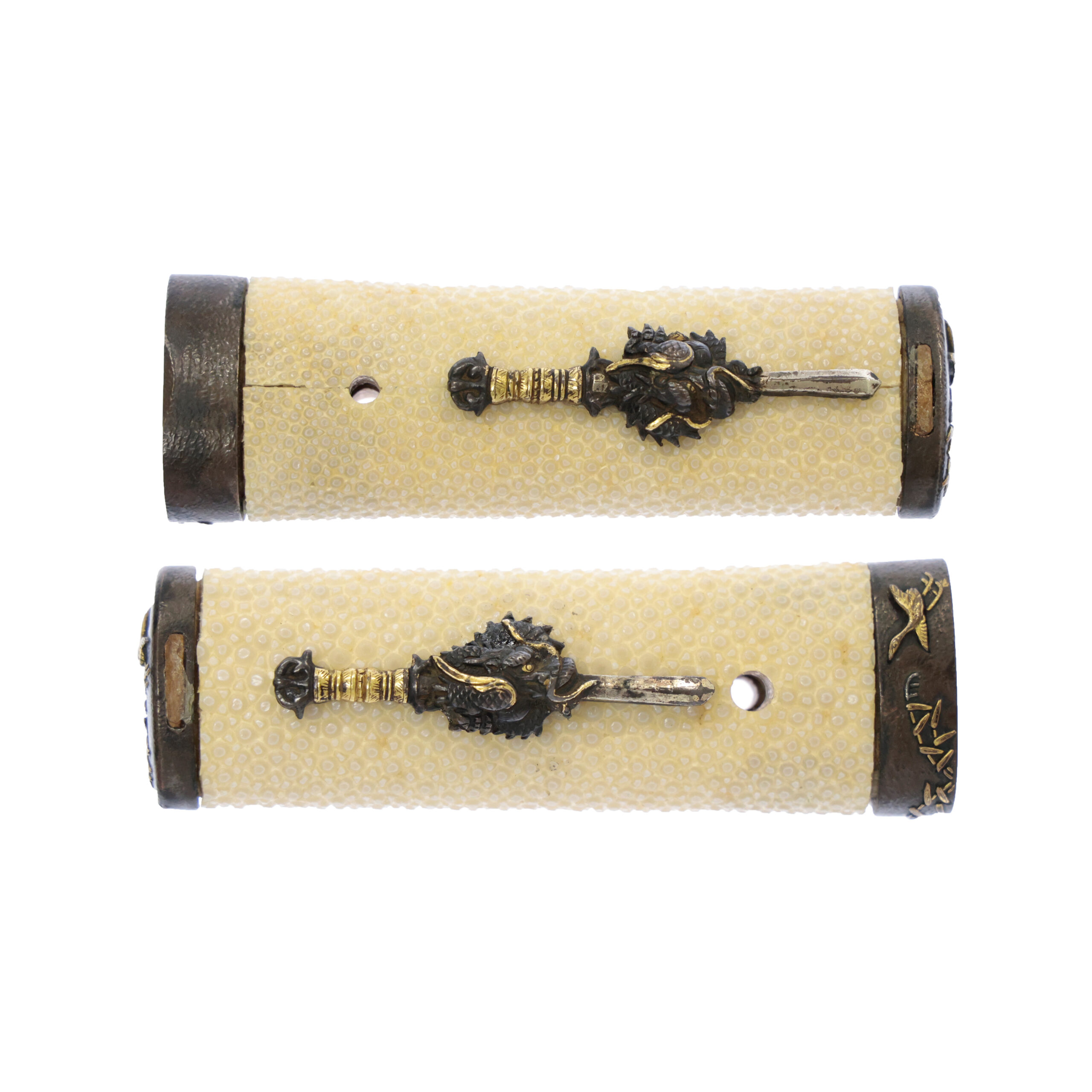

Habaki:Habaki is the equipment to make the blade not touch its scabbard inside. It prevents the blade from getting rusty and chipped.
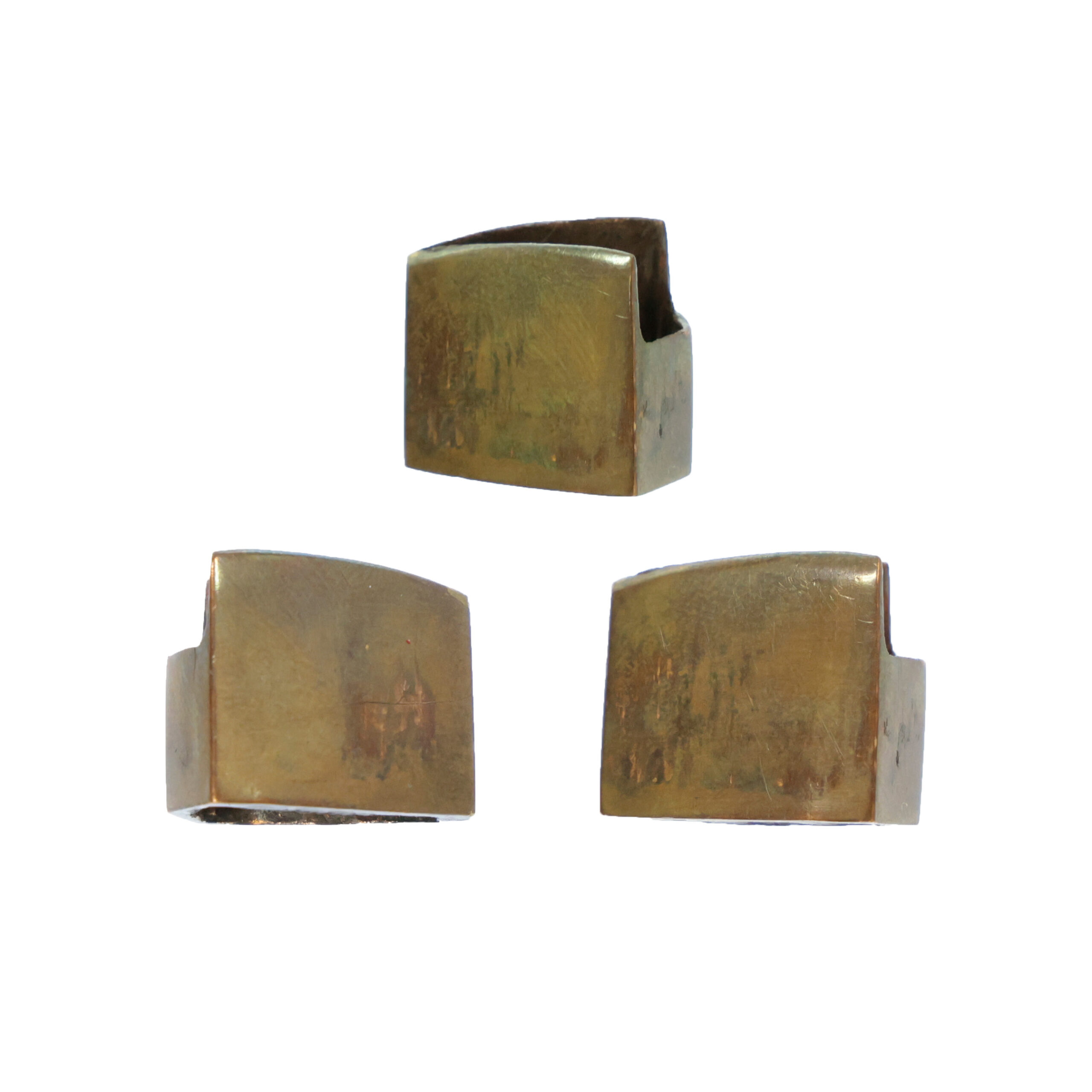
Saya: Saya is the scabbard for the Japanese sword.
This Saya has the same motif, Kurikara-Ken (倶利伽羅剣), as the Menuki. Also, the pattern carved around the Kurikara-Ken might be flames. In Kurikara design, the dragon is sometimes depicted as a burning flame wrapped around the sword. This pattern is applied throughout this Saya, adding to its powerful impression.

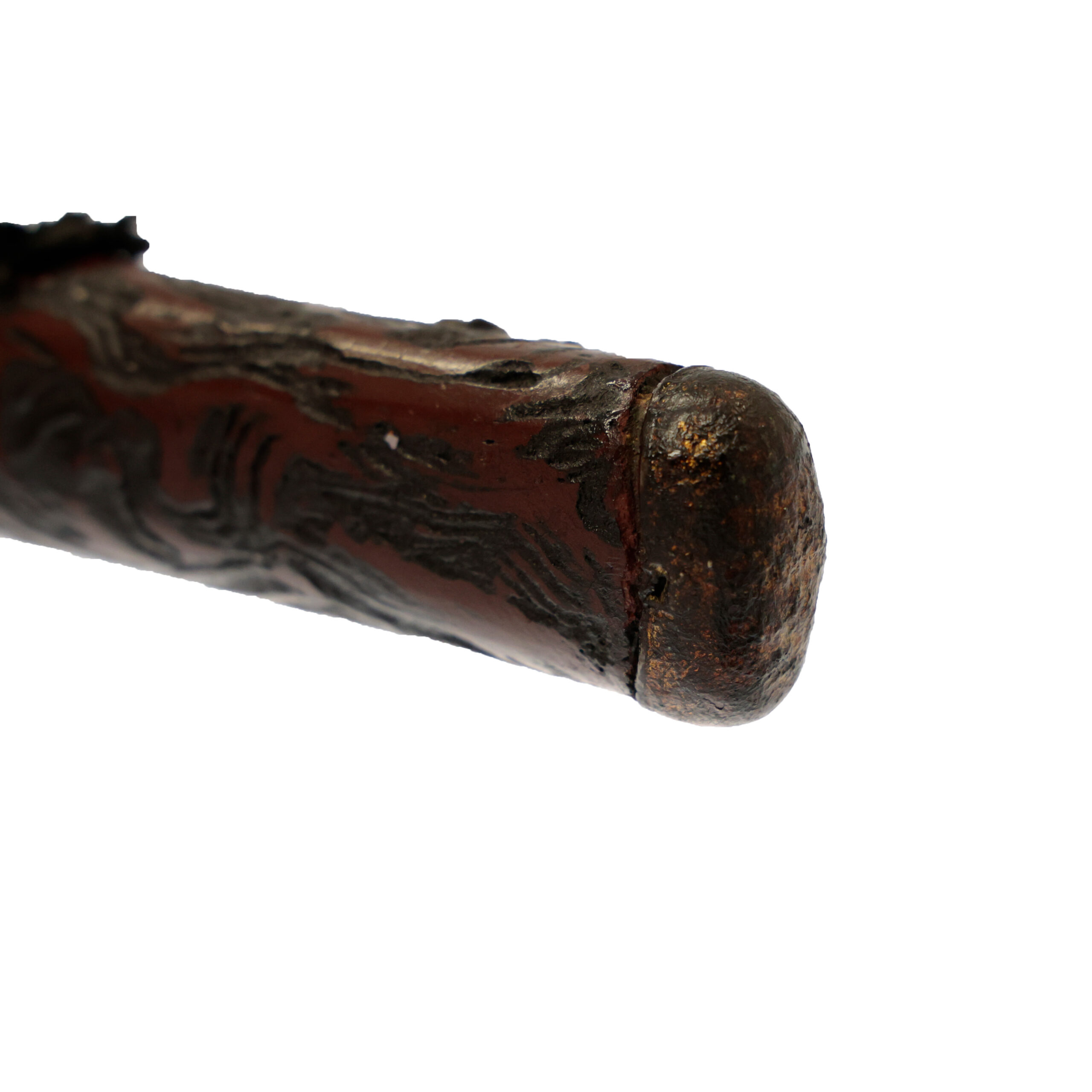
Authentication Paper:NTHK Kanteisho Certificate for the blade (No. 12787)
NTHK, also known as NPO Nihon Touken Hozon Kai, is the oldest organization for sword authentication of Japanese swords in modern times. It was established in 1889 during the post-Samurai era. They authenticated the blade on September 15th in the 6th year of Reiwa (2024). The purchaser will receive this original certificate as well. We can also translate what is written into English and make a PDF file for your record if you request.
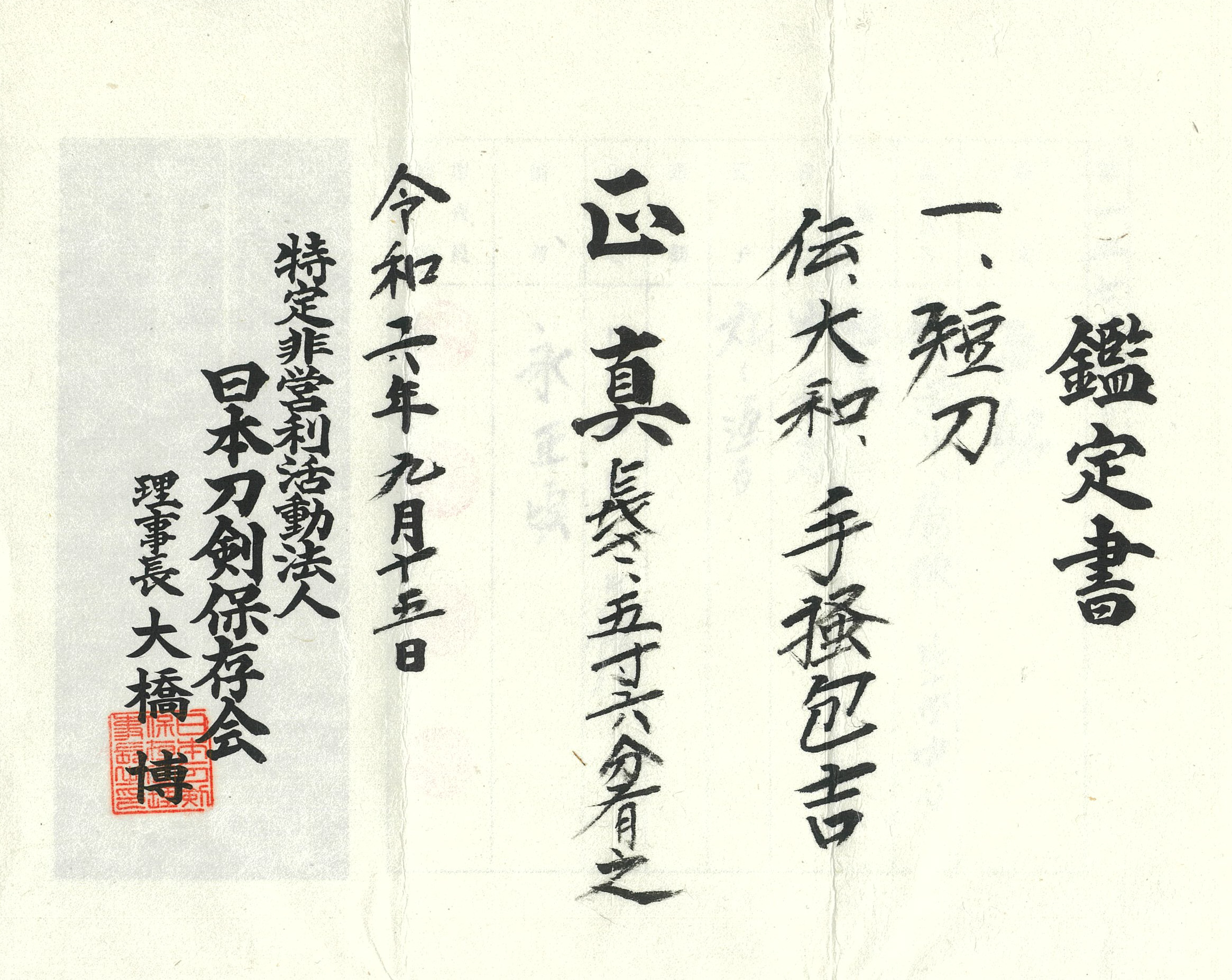

Registration Number : Nagano 40913
The Board of Education in Nagano prefecture issued a registration paper for this sword. It is called Jyu Token Rui Torokusho (銃刀剣類登録証). Bunkacho (The Agency for Cultural Affairs) acknowledges a Japanese sword with this paper as a work of art.
The sword needs to be traditionally hand-forged and made of Tamahagane carbon steel to be registered in the system. With this paper, its owner in Japan can legally own an authentic Japanese sword. Based on this registration number, we will apply for its export permit.
This paper will need to be returned to the board of education when the sword is being shipped abroad, but you can receive a copy of it. An English translation of this registration paper is available on request.

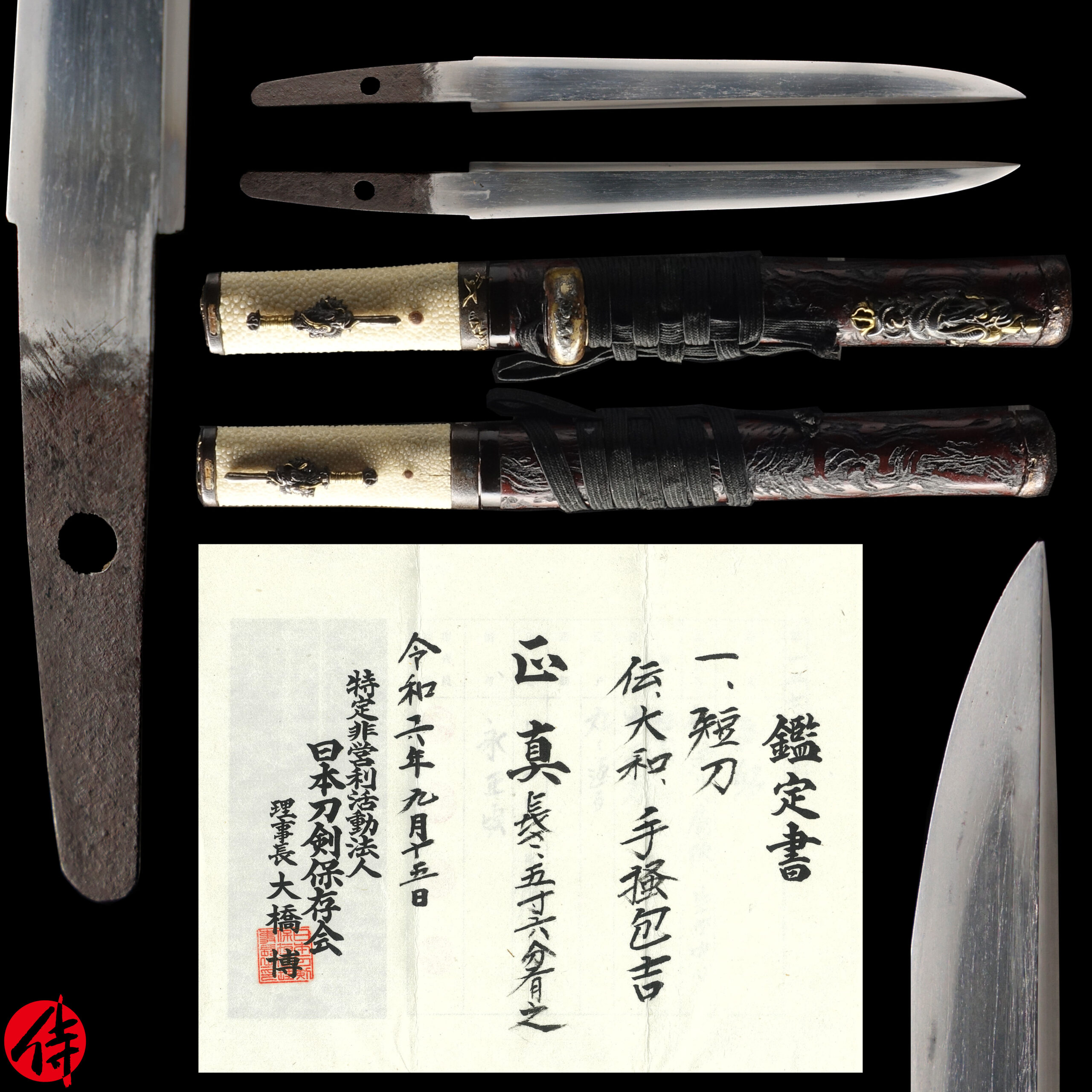
—————————————————————–
【About us】
Samurai Museum is located in Tokyo, Japan, exhibiting antique artifacts related to the Samurai history. Samurai Museum Shop is the place for those who are interested in Japanese culture and craftsmanship. We deal with antique Samurai swords/armor, traditional crafts made in Japan and so on.
【Japanese Sword& Export Process】
The Japanese swords we deal with are hand-forged edged swords made in Japan. It was made from the traditional carbon steel called TAMAHAGANE(玉鋼). Samurai Museum is familiar with the proper legal procedure for an antique/ authentic Japanese sword to be exported from Japan. We have sent more than 500 Japanese swords for the past three years (~2023) to amazing owners who appreciate its historical value.
Each Japanese sword is registered under the Agency for Cultural Affairs and the Board of Education in Japan. They issue a registration paper for each Japanese sword for its owner in Japan to legally possess it. The Japanese sword with its registration paper means it was traditionally hand-forged in Japan.
To legally export the sword from Japan to other countries, we will have to apply for its permit to the Agency for Cultural Affairs(Bunkacho) and return the original registration paper to the Board of Education. It normally takes around 2-4 weeks to receive this permit after submitting required documents. And we would like you to expect at least 1-1.5 months for your order to arrive at your given address after you ordered. For more detailed info, please click here.
It is allowed for residents in Japan to own authentic Japanese swords without a special license as long as they come with registration papers. Please feel free to contact us if you are a resident of Japan, whether temporarily or permanently. We will also assist you when you leave Japan and need to obtain the export permit.
【Payment Method】
We accept payment through Stripe (Credit card), PayPal, Apple Pay or ChromePay, all of which are secure payment methods. Also, you don’t need to make an account on Stripe for the checkout. If you prefer other payment method, please contact us. After confirming your payment, we will apply for an export permit. You may either pay in JPY, USD, AUD, CAD,EUR CHF or GBP. The price is set in Japanese Yen. Prices in other currencies are automatically calculated based on the latest exchange rate.

* If the amount is above 1 million JPY, Stripe or wire transfer will be the only options for payment.
【Shipping】
We have shipped authentic Japanese swords to the USA, Canada, Mexico, Germany, France, Hong Kong and Australia. If you don’t live in these countries and like to order, please contact us first before making a purchase. We offer Free International Shipping as long as we can send antique Japanese swords by EMS.
We normally ship by EMS(Express Mail Service) provided by Japan Post. We will send you a tracking number for your order as soon as we hand it to the post office. We will put 100 % insurance on the shipping document without any extra charge. Based on the total amount, there might be a duty tax or other fee for you to pay, depending on the countries. We use package cushioning to protect the item and put it in a PVC pipe, which is one of the most secure packages because of its durability.
It will normally takes 5-14 days for the item to arrive at your given address after we dispatch it. Time of delivery is estimated as accurately as possible by the carrier but does not take into account any delays beyond our control such as by inclement weather, post office holiday seasons.
* If you live in Australia and like to purchase an authentic Japanese sword, please click here to know the detail.

【Review】
Here is one of the reviews we received from a customer who purchased an authentic Japanese sword from us. For more reviews, please click here.
“My experience overall with the whole process was wonderful. I had many questions about the history and process to purchase these treasures. All my questions were answered very timely and complete. The staff is very knowledgeable and very well versed if any questions do arise.”
【How to make sure the condition】
Please keep in mind that what you are going to purchase is an antique item. We uploaded high resolution photos for you to check its condition thoroughly. If you like to see more photos with different angles, please feel free to contact us. We will be happy to send them to you so that you can make informed decision. It is essential for us to know that you are happy with your choice of a sword. and we are prepared to use the best of our ability to serve you.
【How To Contact Us】
Please contact us through email, Facebook Messenger or Live Chat if you have any questions. You can find each icon on the right side of the website. Please click one of them to reach us. We will reply to you within 1-2 business days.
【The Art of Nihonto (Japanese Sword)】
Samurai’s history is a profound, eloquent legacy of ancient Japanese warriors in which millions of people worldwide are being fascinated. If you like to find out the art of Nihonto, please click here.
【A Guide to Japanese Sword Maintenance】
After acquiring an genuine Japanese sword, it is also important to know how to take good care of it. Here is the special video for you. Mr. Paul Martin, Japanese sword expert, shows you how to give proper maintenance to your sword. By mastering how to clean the Japanese sword, its aesthetic beauty will last forever.
When you purchase a Japanese sword from us, you can get a Free Japanese sword maintenance kit. It comes with four tools(Choji Oil, Uchiko Whetstone Powder, Peg remover, Oil Applicator). By watching the video instruction above , you can enjoy learning how to maintain your Japanese sword while appreciating it. If you have any difficulty assembling the sword or cleaning the blade, you can feel free to contact us.
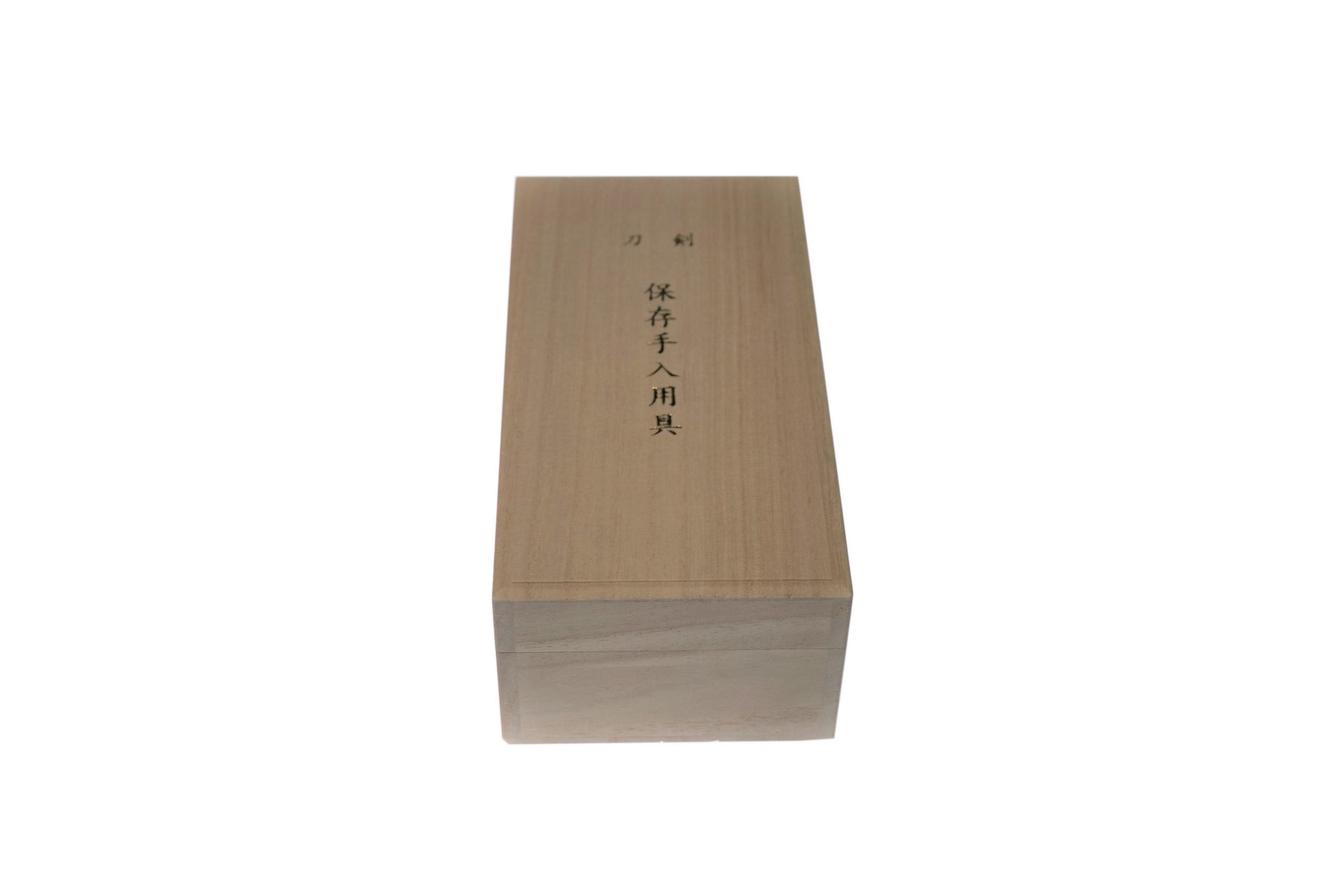
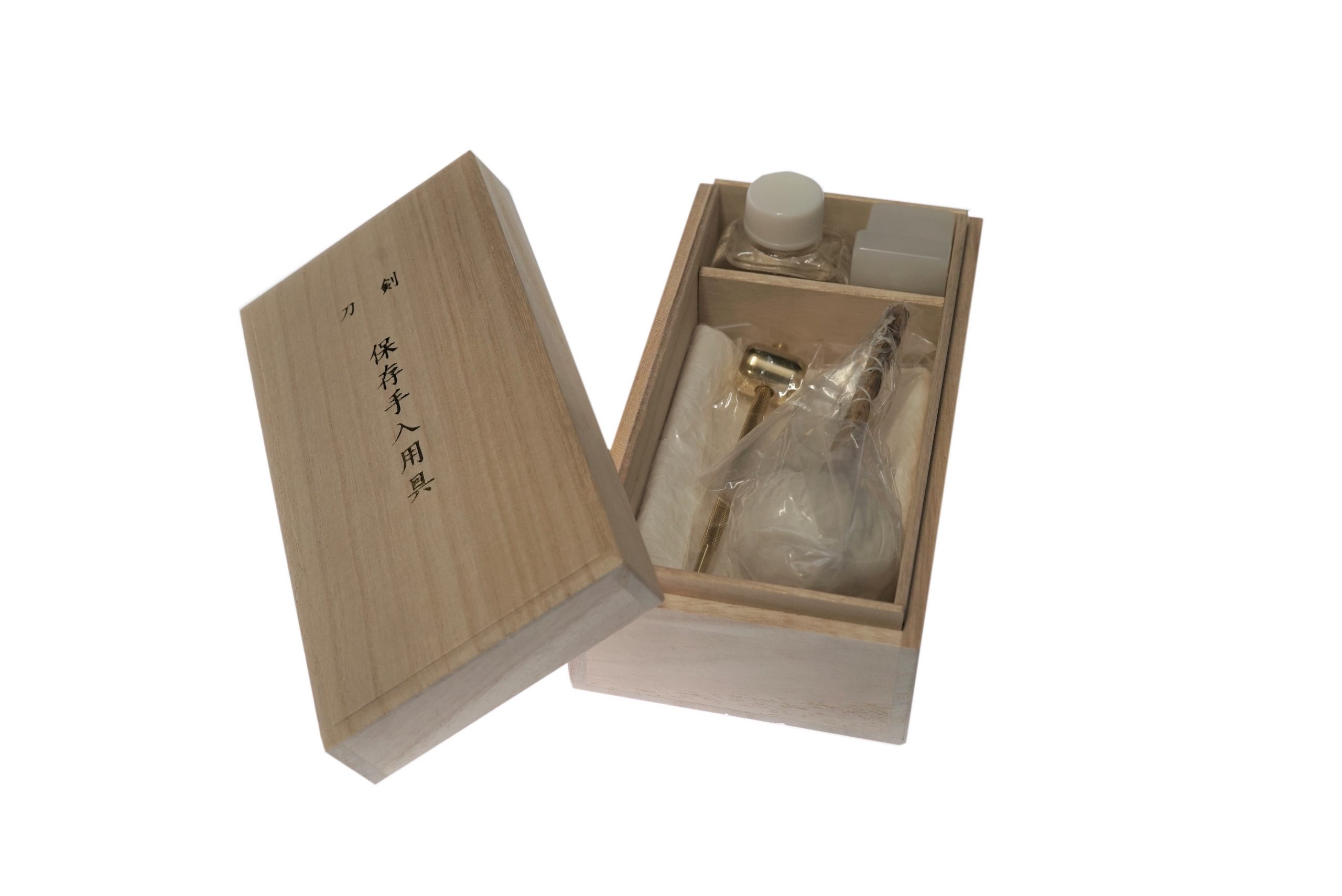
MORE ANTIQUE JAPANESE SWORD FOR SALE
SWORDS WITHOUT CERTIFICATES FOR SALE
LEARN JAPANESE SWORD TERMINOLOGY
Thank you for reading all the information on the page. If you have any difficulty choosing the right Japanese sword for you, we will be more than happy to help you find the one that speaks to you the most. Please feel free to contact us.

